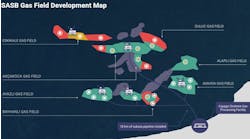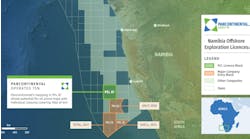Sponsons, concrete berm will resist ice floes
Jeremy Beckman
Editor, Europe
Specially designed sponsons have been fitted to the barge to improve its resistance to habitual and severe winter ice loads.Russia's recognition that Kazakhstan is the legal owner of its offshore resources paves the way for the OKIOC consortium to start drilling in the Kazakh sector of the Caspian Sea. OKIOC comprises Agip, the BP/Statoil alliance, British Gas, state oil company Kazakhstancaspishelf, Mobil, and Total.
Their first exploration well will target the ultra-shallow water Kashagan formation. Ordinarily, the four-meter water depth would present few operational problems, but with ice buildup a regular hazard in the northern Caspian (starting in the northeast, then spreading west towards Astrakhan), the shallowness exacerbates the difficulties for main contractor Mallard Drilling.
The solution for this initial program is an ice-resistant drilling barge, conceived by Hamburg-based IMPaC Offshore Engineering. IMPaC's engineering manager, Joachim Berger, who led the conceptual and detailed design of the barge hull, has a decade's experience working on ice formation problems for the oil industry, including projects in China's Bohai Bay.
Currently IMPaC is also performing a study on a purpose-built jackup platform for the northern Caspian. The jackup must also be able to operate in shallow water and resist thick ice loads. The intention would be to build all parts of the jackup outside the Caspian, tow them through the connecting canals, and assemble them without assistance from any existing Caspian shipyard.
Resisting ice
Ice is present in the northern Caspian from November through April. Rafted ice can reach thicknesses of up to 1.1 meters during severe winters, leading to pile-ups several meters thick. This was the design case assumed by IMPaC for OKIOC's prgram. Model tests were therefore performed in the ice tank of Hamburgische Schiffbau-Versuchsanstalt to get better information on the design ice forces and to simulate the piling-up of rubble ice.Following various conceptual design studies, the decision was taken to use an existing swamp barge owned by Mallard with sponsons fitted port and starboard to withstand ice loads. These were attached during modification work in Louisiana.
The sponsons, built by Lindenau shipyard in Kiel, Germany, were wet towed this summer to Astrakhan via the Baltic Sea and Russia's canal system from St. Petersburg. These sponsons measrure 84.5 meters long, 16 meters wide and 5.5 meters high. Each weighs 1,100 tons with a 32-mm maximum plate thickness for areas exposed to ice loads.
In parallel, the center section of the converted swamp barge was transported by a heavy lift vessel from Louisiana to the Black Sea, from where it will also be wet towed through the canal system to Astrakhan for mating with the two sponsons. Following outfitting, the drilling barge will then be towed to the Kashagan drilling location.
There, the barge will be positioned on a pre-installed underwater rock berm, less than two meters high, built from local limestone. Once in position, it will be ballasted - the ballast water and the barge's own weight will keep it stable during winter and summer drilling operations.
As Berger points out, there are numerous environmental oddities in this part of the Caspian, including strong wind surge effects, annual water level variations, and long-term water level changes - a phenomenon that is presently not fully understood. This makes it difficult to predict the actual water levels required during installation and removal of the barge.
During operation, the seawater level changes result in varying barge buoyancy forces, which had to be taken into account in the sliding and overturning stability analysis.
The assembled barge will be 84.5 meters long and 52.7 meters wide with a draft of 1.95 meters, with a weight during tow-out to the offshore location of approximately 6,800 tons.
To reduce the global ice loads and to minimize the risk of over-riding by rubble ice, the ice deflectors are partially fixed to the barge deck and partially removable. A coaming is integrated into both deflectors which also runs around the barge's center parts and its outer edges, ensuring zero discharge from the barge into the Caspian Sea.
To counteract ice forces acting on the barge, IMPaC recommended driving piles along the vessel's long sides. According to Berger, this measure should "pre-break" the ice as it forms, forcing it to mount up in front of the piles rather than the barge.
Sensors have been placed on the barge's bottom to measure the vertical and horizontal stresses accumulating between the vessel's bottom and upper deck level. "Through this system, we hope to gain information on whether we are approaching a critical situation," Berger says. Special tests have been carried out to verify the sliding resistance created at the barge bottom and to check the bottom sensor system.
Should evacuation prove mandatory, both sponsons are equipped with a double-hinged ramp through which the three escape vehicles can convey the 100 crew members. These Arktos vehicles are designed to float in summer or to use their caterpillar tracks in winter, allowing them to travel over the iced-up Caspian surface. The sponsons will also be furnished with two 25-meter long burner booms, the pipework on which will be resistant to sulfide-stress cracking. ABS Hamburg and Houston classified the sponsons.
To extend drilling operations, two icebreakers will travel up the Volga to the Caspian to supply the drilling rig as long as possible during winter periods. Currently OKIOC is building a supply base for offshore operations at Bautino. A problem for OKIOC is that the shallow water militates against large draft supply boats - these must be specially designed, therefore, to support the drilling campaign.
The plan is to drill initially at three separate locations, Kashagan East, Kashagan West, and Aktok. All are situated around 80 km offshore - the exact position is not easy to pinpoint, owing to the fact that the Caspian shoreline shifts as the water level fluctuates.
Should hydrocarbons be found, the underwater rock berm will be left in place with the wellhead sticking out while the barge is towed to its next location.
Then the problem arises of how to protect the temporarily abandoned conductor pile and berm against subsequent ice loads. One solution could be to place a large, ice-resistant pipe around the conductor, preventing ice loads from acting on the wellhead.
Copyright 1998 Oil & Gas Journal. All Rights Reserved.



